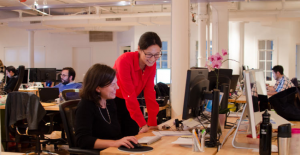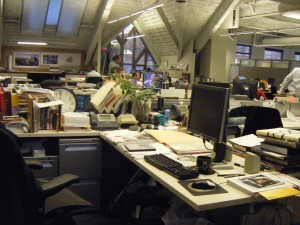Open vs Closed Offices at Fast Co

Two sides of a long-standing workplace design issue.
On one side: Offices for all! Why open-office layouts are bad for employees, bosses, and productivity
And on the other: How to create an open office that is more awesome for both introverts and extroverts
Two senior editors at Fast Company present their reasons with conviction and real life stories.
From the argument for private offices:
Peace and quiet and privacy and decency and respect for all. We people who spend more waking hours at work than we do at home, we people who worked hard to be where we are, we deserve a few square feet and a door. …
This is the problem with open-office layouts: It assumes that everyone’s time belongs to everyone else. It doesn’t. We are here to work together, sure, but most of the time, we actually work alone. That’s what work is: It is a vacillation between collaboration and solitary exploration. One isn’t useful without the other. When we are working in a group–literally when we sit around a table brainstorming, or when we are having a conversation–we don’t pretend we’re alone. That would just be weird and awkward. So when we’re alone, let’s not pretend we’re in a group. …
At the last magazine I worked for, everyone had offices. We’d pop into each other’s offices, at first to ask a question or work out some problem, and soon, because nobody could hear us, we’d transition into long and personal conversations. Many people there became close, treasured friends, and awesome collaborators.
But out in the open? It’s far harder to get to know coworkers–and that personal connection is important. “Serendipity” isn’t a matter of matched-up ideas. It’s a matter of knowing how another person thinks. That’s the kind of stuff you learn by getting personal, and that’s not something I want to do out in the open.
From the argument for well-designed open offices:
If it’s done right, getting rid of physical barriers can help cut down on email overload. For example, when GlaxoSmithKline moved its workers from cubicles and offices to open-plan work tables, “email traffic dropped by more than 50%, while decision making accelerated by some 25% because workers were able to meet informally instead of volleying emails from offices and cubes,” according to the Wall Street Journal. …
Almost every open office proponent I spoke to pointed to the importance of diverse spaces in a workplace. Noise, interruptions, and lack of privacy are definitely a problem in open workspaces, and not everyone in an office works the same way or does the same work–which is why giving workers many options in a space is key to open office success. …
If you’re going to provide private phone rooms and private work pods, don’t place them so far away from your employees’ desks that the trek across the office isn’t worth it. …
At my last job, my boss spent half the day sitting at a desk in our open office, working with us side-by-side, and half the day in his private office a few feet away, drilling down on other work. It was a great system because it allowed him to understand, first hand, what his employees’ days were like–and made us employees believe he understood our workflow problems, too. …
Both of these posts are in the dialed section on Fast Company’s website, as is this one: The 10 worst things about working in an open-office — in your words.
When I worked in a good-sized open plan office, I loved it. There were small rooms (‘huddle rooms’) nearby with doors for private work or conversation. But at my desk I got a sense of what was going on in the teams around me by the chatter, the impromptu desk-side meetings, the expressions on faces, the general level of activity, the mood. It helped me know who might need information, what projects were active, who was on the project team. None of which I had in an earlier iteration of the same office, when the library I ran was in the center of the floor plate, “the heart of the office”, a lovely sentiment but it meant that I only saw people when they happened to pass by or on my regular walks through the studios. So, for me, open office worked well.
How about you? Do you prefer open office, or having a private office?
Update: from the New Yorker, Jan 7, The Open-Office Trap, cites quite a number of studies indicating negative effects of noise and stress in an open office environment.

